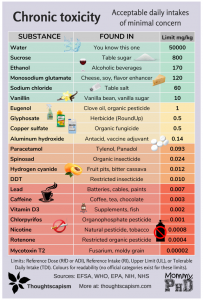Whether you realize it or not, we are inundated with fear-based marketing labels every time we set foot in a grocery store. The labels may seem innocent, and you may believe they are giving you helpful information in order to make educated food choices, however, the reality is that these labels are actually doing quite the opposite.
The deception doesn’t end there, unfortunately: Biased, agenda driven organizations such as the Environmental Working Group publish fear mongering headlines all the time based on junk “studies” they’ve conducted. People share the articles without looking into the validity of them, the media reports on it because it brings in viewers, and many of us become unnecessarily scared of our food despite being fortunate enough to have some of the safest food in the world and in history.
Here’s what to look out for next time you head out to the grocery store so that you can start making food purchasing decisions based on #FactsNotFear and save a little money in the meantime, too!
1. Don’t be fooled by the Non-GMO Project Verified label — you don’t need to avoid “GMOs”
This label can be found on everything from bottled water to table salt, but why does the Non-GMO Project allow for its label to be put on products that don’t even contain genes? Because they’re capitalizing off of consumer’s unnecessary fear of “GMOs.” Many consumers assume that if a product has a non-GMO label, it must be superior to a similar product next to it without that label, but that’s not true at all. First, just because a food product doesn’t have a non-GMO label doesn’t mean it’s “GMO.” There are only 10 “GMOs” available for sale in the U.S. today. Second, “GMOs” have been extensively tested and are just as safe and nutritious as their non-GMO counterparts, so there’s really no reason to avoid them. Lastly, almost everything grown today has been genetically modified at some point in time. Farmers have been cross breeding plants for thousands of years as well as using a technique known as mutagenesis since the 1930s, in which radiation and chemicals are used to induce random genetic mutations.
Thousands of mutagenic crops exist today, however, both crossbred and mutagenic crops are not considered to be “GMO” by the Non-GMO Project and can be labeled as non-GMO and USDA Certified Organic. The Non-GMO Project only considers transgenic crops as “GMOs” even though transgenesis is a much more precise genetic modification technique and is highly regulated. “GMOs” also allow for reduced pesticide use and more often allow more farmers to adopt no-till farming methods, which increase soil biodiversity, decrease soil erosion, and decrease greenhouse gas emissions. Not only does the Non-GMO Project’s deceptive label not tell you much of anything about your food, but it also creates unnecessary fear around foods that are perfectly safe and nutritious and allow for more environmentally friendly farming practices.
#FactsNotFear: Don’t pay more for the Non-GMO Project Verified fear-based marketing label.
2. USDA Certified Organic labels don’t tell you anything about the safety or nutrition of foods
USDA Certified Organic is nothing more than a food production process that has been defined by the USDA, which states that its regulations “do not address food safety or nutrition.” In fact, organic foods are no safer or more nutritious than their conventional counterparts. There is very little evidence showing significant differences in nutritional value of organic and conventional foods. Any differences that have been found are too small to have any effects on human health. Additionally, organic foods are not pesticide free, like many people may think. Organic farmers are allowed to use approved organic pesticides as well as some approved synthetic pesticides, and some organic approved pesticides have even higher toxicities than synthetic pesticides allowed in conventional farming. USDA Organic regulations also do not allow antibiotics and growth hormones to be used on livestock, but that doesn’t make organic meat any safer or more nutritious, in fact, it’s not (see #3).
Organic also doesn’t allow “GMOs” which, as we discussed previously, doesn’t mean much. If you purchase organic specifically because you think it’s better for the environment, well, that’s not supported by the scientific evidence either. Conventional farming is actually usually better for the environment. The inherent restrictions required in organic farming result in organic farmers sometimes having to use more toxic pesticides and less environmentally-friendly technology and farming practices. So, stop being scared of conventional foods and paying more for organic. It’s simply not worth it.
#FactsNotFear: Don’t pay more for organic — it’s no safer or more nutritious then conventional, and it’s worse for the environment.
3. “Hormone Free” and “Antibiotic Free” labels are meaningless
The USDA banned added hormones in both organic and conventional poultry in the 1950s. So, if you’ve been paying extra for the “No Added Hormones” label on your chicken or turkey you can definitely make sure to stop doing that. The use of hormones in pigs is also banned. Hormones are allowed to be provided to beef cattle so that they grow quicker and, therefore, require less feed. A recent study examined the environmental footprint of beef production with and without hormone implants and found that the use of hormones reduce greenhouse gas emissions by about 5 percent. The meat from these animals is safe for consumption at any time since the hormones that they naturally produce are at much higher levels than the amount added. There is no nutritional difference between meat from a steer that’s had a hormone implant and one that has not, because the actual difference in hormone levels is a fraction of a billionth of a gram. rbST, a cow growth hormone that increases milk production, can be used in dairy cows in the U.S., but is rarely used. rbST has not been shown to impact human health, which is why anything labeled “milk from cows not treated with rBST” is required to also have the following statement “no significant difference has been shown between milk derived from rBST treated and non rBST treated cows.”
Antibiotics are used in food animals just as they are used for people; to treat them if they become sick. Currently there is no single definition for “antibiotic-free” on food labels. It is not a USDA approved label and has no clear meaning. All animal farming must obey strict rules to ensure no antibiotics are in the animal’s system before it can be slaughtered for food. Therefore, there are no antibiotic residues in your food regardless of whether that animal received antibiotics during its lifetime or not.
#FactsNotFear: Don’t pay more for meaningless labels such as “No Added Hormones” or “Antibiotic Free.”
4. Disregard the “Dirty Dozen” list that’s published by the Environmental Working Group every year.
Please, don’t pay any attention to the “Dirty Dozen” or “Clean Fifteen” lists that the EWG publishes every year. In fact, do yourself a favor and disregard every report and “study” published by the EWG. They are a highly biased organization that is largely funded by the organic industry. First, these lists promote the idea that organic foods don’t have pesticide residues, which is completely false. Second, they count all pesticide detections equally, ignoring what chemical it is, at what level it was detected and how that compares to the EPA crop-chemical-specific tolerances. For example, a crop that has residues from seven pesticides could rank “dirtier” than a crop with three pesticides, even if those three pesticides were at an overall greater amount and of higher toxicity. The EWG misuses the data from the USDA’s Pesticide Data Program, which shows how insignificant these residues are from a health perspective, to manipulate the data to drive their fear-based, organic marketing agenda. The EPA sets extremely conservative “tolerances” for pesticide residues based on an extensive and rigorous risk assessment that reflects all of the toxicological information available. To learn more about how this is done and just how incredibly conservative these levels are, please refer to my Facebook posts here and here. The pesticide residues found on both conventional and organic produce are at extremely safe levels.
Don’t give pesticide residues a second thought at the grocery store. Take pride in the fact that our food supply is extremely safe. A study published in the Journal of Toxicology tested whether the “dirty dozen” was indeed, dirty, and concluded that “consumer exposures to the ten most frequently detected pesticides on EWG’s ‘Dirty Dozen’ commodity list are at negligible levels and that the EWG methodology is insufficient to allow any meaningful rankings among commodities. We concur with EWG President Kenneth Cook who maintains that ‘We recommend that people eat healthy by eating more fruits and vegetables, whether conventional or organic,’ but our findings do not indicate that substituting organic forms of the “Dirty Dozen” commodities for conventional forms will lead to any measurable consumer health benefit.” Most Americans aren’t getting nearly enough servings of fruits and veggies a day. It is far more advantageous for your health to eat more produce than to limit it because of unnecessary fear of pesticides or to eat less because you’re scared into paying more for organic.
#FactsNotFear: Ignore the EWG’s “Dirty Dozen” and just make sure you’re getting enough fruits and veggies.
5. Don’t avoid foods that you’ve heard have “toxic levels of glyphosate” — it’s simply not true
“Breakfast With a Dose of Roundup?” You all remember the fear inducing headline that the EWG put out back in August. The EWG claims that it found up to 530 ppb of glyphosate, the active ingredient in Roundup, in the samples of Cheerios that were tested in their non-peer reviewed “study.” Well, I decided to do some math to determine exactly what amount of Cheerios a child or an adult would have to eat to reach the max Acceptable Daily Intake (ADI) of minimal concern according to the table below, which would be 0.5 mg/kg for glyphosate.
A 30-pound child under age 4 would have to eat 610 SERVINGS PER DAY or 458 CUPS OF CHEERIOS PER DAY, and a 150-pound adult would have to eat 2291 CUPS PER DAY for an extended period of time to reach the maximum ADI of glyphosate.
This is the definition of fearmongering. A catchy headline, some random, insignificant data that sounds scary, and a conclusion that doesn’t mention the fact that you’d have to eat so much of the food tested that the actual food would kill you well before the glyphosate would have any effect. You can disregard any article you’ve seen proposing that glyphosate is at “toxic” levels in our foods. Glyphosate is one of the most heavily studied chemicals in history. There’s not one study showing that these almost undetectable levels of glyphosate residues in foods have caused any harm to humans. A multi-university research project funded by the U.S. Department of Agriculture concluded that glyphosate, if accidentally consumed, undergoes little metabolism, does not accumulate and is excreted mostly unchanged in feces and urine. A good rule of thumb is that if someone tells you that a chemical is toxic, yet they fail to tell you the dose that is toxic and the concentration in which it occurs in the food, they are either trying to deceive you, have no idea what they’re talking about or are trying to sell you something. After all, everything can be toxic at a high enough dose, even water.
#FactsNotFear: Ignore the fearmongering around glyphosate. It’s one of the safest, most effective and most environmentally friendly herbicides used in farming today and, if detected in foods, is at negligible levels.

Food Science Babe is the pseudonym of an agvocate and writer who focuses specifically on the science behind our food. She has a degree in chemical engineering and has worked in the food industry for more than decade, both in the conventional and in the natural/organic sectors.



